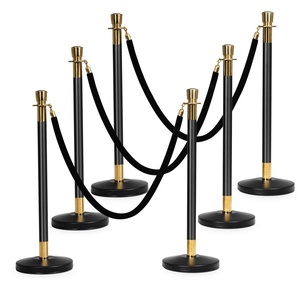(950 products available)






































































































































































A ballet rail, also known as a ballet barre, is an essential piece of equipment for performing arts studios and dancers. These heavy-duty pieces of wood or PVC/Plexiglas are used for warming up, strength training, and for practicing stretches and various other exercises. Ballet rails are not only an integral part of ballet practice but also an essential piece of equipment for fitness centers and those practicing Pilates.
Ballet rails come in different shapes and sizes according to the needs of the studio, the dancers, and the available space. Freestanding ballets bars are popular since they can easily be moved around and used in different areas. Additionally, they are safer since hazards such as falling are minimized. Another form of the ballet rail that is used frequently is the wall-mounted bar. These bars are typically suspended horizontally against the wall and can be used in single or multiple parallel settings. They can be mounted at various heights convenient for both instructors and students.
Dependent on goals, training needs, age, and flexibility, ballet rails are usually categorized into beginner, intermediate, and advanced levels. Beginners generally look for bars with a height of 24". Intermediate users would seek ballet rails at the height of 30", while the advanced level would use rails that are 38" tall. Advanced practitioners can also use double ballet bars, which offer more support and help. Other variations that might be found in ballet rails include L, T, and U shapes where the barre is mounted against the wall in those specific shapes. These configurations are also referred to as corner ballets.
Typically, ballet bars are made from beech, birch, ash, oak, maple, or even PVC. The bars are smooth and have a faint grain to them. The main consideration is to use a material that is not too slippery and not too rough on the skin. Aside from wood and PVC, aluminum bars have also become quite popular. Aluminum ballet bars are practical for both indoor and outdoor studios and are easy to clean and maintain.
Ballet rails are an essential piece of equipment for dancers to warm up, stretch and perform various other exercises. Studios or individuals can look for suppliers and wholesalers of ballet rails on this platform.
The height of a ballet barre is crucial. It must be sufficient to support the dancers as they stretch and perform various exercises, thus mimicking the hip height. A typical ballet barre height is as follows:
Barre diameters vary according to the material used and the weight they need to support:
These dimensions are fine for a ballet dancer, but they may need to be resized for people with different body shapes and sizes.
A ballet barre's stability is critical for both companies and customers. The support legs of a ballet barre 100cm height are used to measure stability.
Cross members connect the base and top, which is the ballet barre. Like the legs, the cross members must have the same proportions to ensure comprehensive stability. Support legs are almost always adjustable to cater to uneven floors and changing height requirements.
Maintenance requirements for ballet barres according to guidelines from those who supply ballet barre rail for sale are as follows:
Apart from providing support to dancers practicing their stances, there are several other ways ballet rails are used to provide support and foster inclusivity in various places.
The following tips may help those looking for ballet rails for sale.
Choose the Right Length
When shopping for a ballet barre, it is important to look for choices with lengths that can accommodate the intended users. The lengths vary with different age groups, from preschool to adults. For children, a starting length can be one meter, and for teens and adults, one that is 2.44 meters long should work.
Select an Appropriate Height
Ballet bars come in different heights to suit different users. For children, a good height is between 75 cm to 90 cm, and for teens and adults between 90 cm to 120 cm. Choosing adjustable bars can accommodate different user heights.
Consider the Material
The material used to construct the barre affects its performance and durability. Wood is the traditional material that most ballet dancers prefer for its natural feel and warmth. Metal is more durable and is suitable for heavy users or those who intend to use the barre in commercial spaces.
Select the Proper Weight
For stability during practice, choose a ballet barre with the proper weight. Metal bars are heavier than wood ones, and standalone bars are heavier than wall-mounted ones. Choosing the proper weight minimizes the risk of tipping over and sliding during practice.
Opt for Safety and Stability
Safety and stability should be a priority when selecting ballet bars. They should come with rubber feet to prevent slips on hardwood floors. Dancers must feel confident and safe when holding onto the barre.
Q: Who uses a ballet barre?
A: Ballet bars are primarily used by ballet dancers. However, other dancers and athletes who engage in barre workouts or other stretching and strengthening activities also use them. Some facilities may accommodate this request.
Q: How many barres are in a ballet studio?
A: The number of barres in a ballet studio depends on the studio's size and the available space. Smaller studios might have one or two barres, while larger studios can accommodate more barres. Some studios have portable barres so that they can set up the studio according to their needs.
Q: Can the ballet rail be used outdoors?
A: Outdoor ballet barre rails are available for those who want to practice outside. These are made of weather-resistant materials and can be used in gardens, parks, or other outdoor settings.